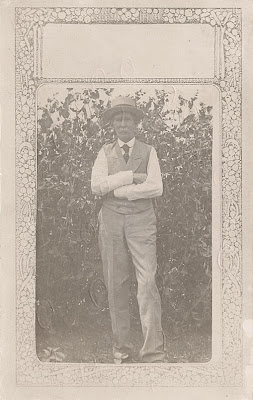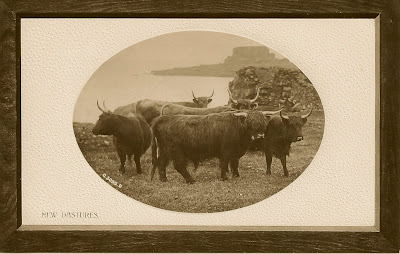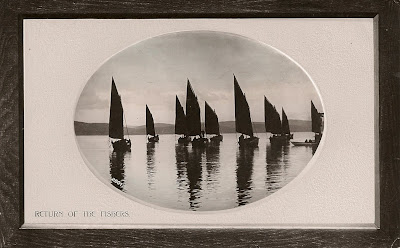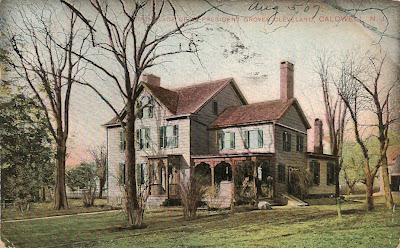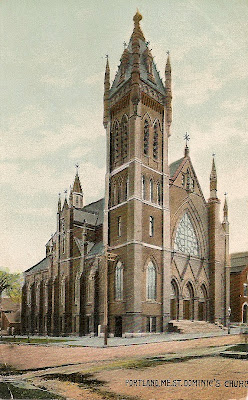
This is a moderately interesting postcard view of the City Hall Park in lower Manhattan area looking with the East River and Brooklyn in the background; the long low building pointing across the river just left of center is, I'm told, the terminal for the cable cars of the New York and Brooklyn Bridge Railway. Although it may not be immediately evident in the above scan, the card has been extensively decorated with glitter, which is easiest to spot on the horizontal lines of the tall building in the center of the frame. It was manufactured by the Rotograph Co. in Germany and bears the Sol Art Prints trademark. The stamp on the reverse has been cancelled but there's no date; 1906-1908 would be a good guess.

As interesting as the view itself, perhaps, is the brief message on the front and the person to whom it was addressed. The recipient was Mr. W. G. Greenawalt of 1428 Chestnut Street in Philadelphia, and the inscription ("These ought to sell well – With Phila views. J. R. M.") would have been of particular interest to him, for Greenawalt, a pharmacist, was the author of several articles on postcards written from the retailer's point-of-view, articles that appeared in now obscure -- but surprisingly lively -- trade journals. Here, for example, are the beginning paragraphs of an article on "Making Capital of the Post-card Craze," which appeared in May 1908 in the
Bulletin of Pharmacy:Having traveled abroad, and knowing the popularity of picture post-cards, as most foreigners call them, I watched with eager interest their advent into America. I felt that they would become just as popular here, if not more so.
When they were first coming into vogue, I was located up on Broadway in New York. I was one of the pioneers in the post-card business, making some of the first window displays to be seen on Broadway.
Knowing that human nature is much the same in all countries, and feeling sure that Americans would buy postal cards at home, just as the travelers and tourists did abroad, I displayed a few local views. Gradually I added others of a fancy nature — flowers, fruits, dogs, cats, and later scenes from the various cities of the East.
I soon realized that my theory was correct. Americans did buy them, and I was developing quite a nice trade in souvenir cards, when a real estate deal brought a change of location. I came to Philadelphia*, where I located on Chestnut Street.
Here again, with renewed energy and zeal, with my confidence in the souvenir postal cards unshaken, I gave them a conspicuous place in my store and began making window displays. Never shall I forget the comments, the criticisms and sneers which followed: "Picture postal cards, a whole window full, in a drug store on Chestnut Street!"
Some laughed, while others took the matter much more seriously. But many who stopped to scoff remained to admire and came in to buy. Notwithstanding adverse criticisms, I continued to show postals, making occasional window displays. Finally, it became quite the proper thing, for others followed as soon as they saw what was being done.

Incidentally, the
American Druggist and Pharmaceutical Record of June 13, 1904 records the druggist's move from New York to Philadelphia, in a somewhat mocking tone that suggests there may have been a whiff of disapproval in the industry over the way he ran his business:
William G. Greenawalt, of Chambersburg, Pa., who opened a pharmacy on Broadway, near Twenty-eighth street, Manhattan, about 18 months ago, has either found the pace too swift for him, or the New Yorkers unappreciative of certain innovations to which he tried to accustom them, for he has shut up shop and removed to Philadelphia, most of his stock and fixtures being transferred to his new location in the Y.M.C.A. Building at 1428 Chestnut street, Philadelphia.
The
Alumni Report of the Philadelphia College of Pharmacy Alumni Association for August 1904 put a more positive spin on the move, declaring that the New York store was "both a sensation and a success," and that its owner "was induced by a handsome offer (owing to the great rise in real estate values) to sell his unexpired lease." The reference to "innovations" in the one account, and "sensation" in the second, makes one wonder whether Greenawalt's display windows of postcards might not have been raising a ruckus.
Not everyone was enthusiastic about the coming of the postcard craze, particularly since "naughty" or "vulgar" comic cards quickly gained a foothold in the market. Greenawalt was reassuring, however. The March issue of the
Bulletin of Pharmacy records the druggist's views on the controversial topic of "The Propriety of Selling Souvenir Post-cards":
In a paper read before the Pennsylvania Pharmaceutical Association, W. G. Greenawalt dwelt incidentally on his attitude toward the fitness of carrying postal cards. Mr. Greenawalt said, in part: "As a business bringer the post-card is one of the best we have ever had, and it bids fair to continue. There are post-cards and post-cards. There are those of a high class, which have an educating and refining influence, and their sale adds to the tone and dignity of any establishment in which they are found. There are others much less so, yet still attractive and interesting, and also the cheaper common ones, which are crude, coarse, and often vulgar. These naturally prove a disadvantage, but it is good to know that few pharmacists have taken them up. Generally he prefers better cards, and so long as he does so he will most surely derive profit and pleasure, even though his ethical sensibilities are shocked. However, he has as his defense that he must live, and if the sale of souvenirs and post-cards is creditable, and makes him more comfortable than some other side-lines, it should console him for any injury to his feelings in the matter."
In his own article he declared, perhaps prematurely, that
The sale of the comic postal has fallen off, as most persons have no longer any interest in them. That was a passing fad.
Greenawalt's original base of operations was apparently Chambersburg, Pennsylvania, which may also have been his birthplace, around 1865; it appears that he or his family ran a drugstore there for at least twenty years. In the 1900 federal census a "G. William Greenwalt," age 33, was listed as living in that city with his mother and two siblings; both he and his brother David were pharmacists. The 1910 census shows a druggist with the same name, age 45, boarding on Pierrepont Street in Brooklyn, perhaps while traveling on business, and in 1912 the brothers purchased a drugstore in Frederick, Maryland. In 1917, William contributed another article to the
Bulletin of Pharmacy, this one recording his experiences with "An Unusual Caller" to his store. Census records for 1920 have him again living with his siblings on Queen Street in Chambersburg. David was still the proprietor of a pharmacy, but William's occupation was now given as "none." David was still living at the same address in 1930 (occupation "none") but there is no further mention of William. It appears neither brother ever married.
Though the postcard would remain popular throughout the 20th century, the great boom itself lasted only a few years. By 1912 the Rotograph Co., one of the most prolific producers and arguably one of the most aesthetically successful, had ceased operations.
